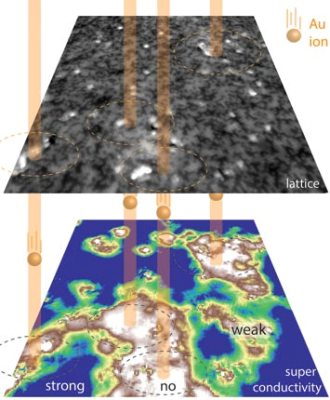May 26 2015
Researchers from the U.S. Department of Energy's (DOE) Brookhaven National Laboratory, the Argonne National Laboratory, and the University of Illinois have shown that superconductivity could be boosted by radiation bombardment.
 High-energy gold ions impact the crystal surface from above at the sites indicated schematically by dashed circles. Measurement of the strength of superconductivity in this same field of view, as shown on the lower panel, reveals how the impact sites are the regions where the superconductivity is also annihilated. In additional studies, the scientists discovered that it is in these same regions that the strongest pinning of quantized vortices occurs, followed at higher magnetic fields by pinning at the single atom crystal damage sites. Pinning the vortices allows high current superconductivity to flow unimpeded through the rest of the sample.$
High-energy gold ions impact the crystal surface from above at the sites indicated schematically by dashed circles. Measurement of the strength of superconductivity in this same field of view, as shown on the lower panel, reveals how the impact sites are the regions where the superconductivity is also annihilated. In additional studies, the scientists discovered that it is in these same regions that the strongest pinning of quantized vortices occurs, followed at higher magnetic fields by pinning at the single atom crystal damage sites. Pinning the vortices allows high current superconductivity to flow unimpeded through the rest of the sample.$
In iron-based high-temperature superconductors, it has been found that a little bombardment could do a significant amount of good. Bombardment using high-energy heavy ions causes damage tracks on the nanometer-scale. This increases the ability of the material to carry high current without decreasing the critical operating temperature, and also without any loss of energy. These high-temperature, high-current superconductors hold promise for energy-generating turbines, and power transmission lines without any loss of energy. In order to enable better utilization, a detailed understanding of the manner in which the damage helps would be useful to create superconductors that possess the optimum characteristics for a specific application.
The research team has published their study as a paper in Science Advances, where they have explained heavy ion radiation bombardment of an iron-based superconductor and the resultant atomic-level flyovers of the pitted landscape. The team performed surface-scanning images, which revealed that specific damage types could fix possible disruptive magnetic vortices in place, and this would block them from any superconductivity interference.
"This study opens a new way forward for designing and understanding high-current, high-performing superconductors," said study co-author J.C. Séamus Davis, a physicist at Brookhaven Lab and Cornell University. "We demonstrated a procedure whereby you can irradiate a sample with heavy ions, visualize what the ions do to the crystal at the atomic scale, and simultaneously see what happens to the superconductivity in precisely the same field of view."
The heavy ion bombardment experiment was led by Wai-Kwong Kwok, a physicist at Argonne. "Heavy ions such as gold can create nearly continuous or discontinuous column shaped damage tracks penetrating through the crystal. As the very high-energy ions traverse the material, they melt the crystal at the atomic scale and destroy the crystal structure over a diameter of a few nanometers. It's important to understand the details of how these atomic-scale defects affect local electronic properties and the macroscopic current carrying capacity of the bulk material," he said.
The way in which the nanoscale defects interact with microscopic magnetic vortices, formed when iron-based superconductors are placed in a strong magnetic field, was of significant interest to the scientists.
"These quantum vortices are like eddies in a river moving across or counter to the direction of flow," Davis said. "They are the enemy of superconductivity. You can't prevent them from forming, but scientists as long ago as the 1970s found you can sometimes prevent them from moving around by shooting some high-energy ions into the material to form atomic-scale damage tracks that trap the vortices."
However, the success of random bombardment cannot be predicted. A quantitative, predictive theory or model for engineering these materials would offer a better approach for scientists.
"If a company comes to us and says we are developing these superconductors and we want them to have this current at a certain temperature in this type of magnetic field, we'd like to be able to tell them exactly what type of defects to introduce," Kwok said.
The team needed a method to map out the superconductivity, the vortice locations, and also the defects. Furthermore, a quantitative theoretical model was required for describing the manner in which these variables related to the bulk superconductivity of the material, and also to each other.
Davis had developed a precision spectroscopic-imaging scanning tunneling microscope (SI-STM), which helped map out the characteristics of a material. Freek Massee, a Brookhaven Lab postdoctoral fellow, and Peter Sprau a graduate student of Cornell University, used the tip of the (SI-STM) to scan the surface of the material, and also image the electrons properties, and the landscape below.
The high accuracy enabled the researchers to repeatedly scan the same atoms under varying external conditions and analyze the movement, effect and formation of quantum vortices. Different external conditions included boosted magnetic fields and temperature changes. Massee and Sprau are lead co-authors of this study.
Atomic-scale imaging showed that a type of "collateral damage" and the shape of the high-energy ion damage tracks both affected vortex pinning. The damage tracks could be elongated or point-like. Keeping disruptive eddies in place is considered as vortex pinning. University of Illinois theorists are developing a descriptive framework based on the results of this experiment to predict and check new methods for materials design.
"These studies will really help us solve at which temperature which type of defects will be best for carrying a particular current," Kwok said. "The ability to achieve critical current by design is one of the ultimate goals of the Center for Emergent Superconductivity."
The DOE Office of Science has provided support for this study through the Center for Emergent Superconductivity.